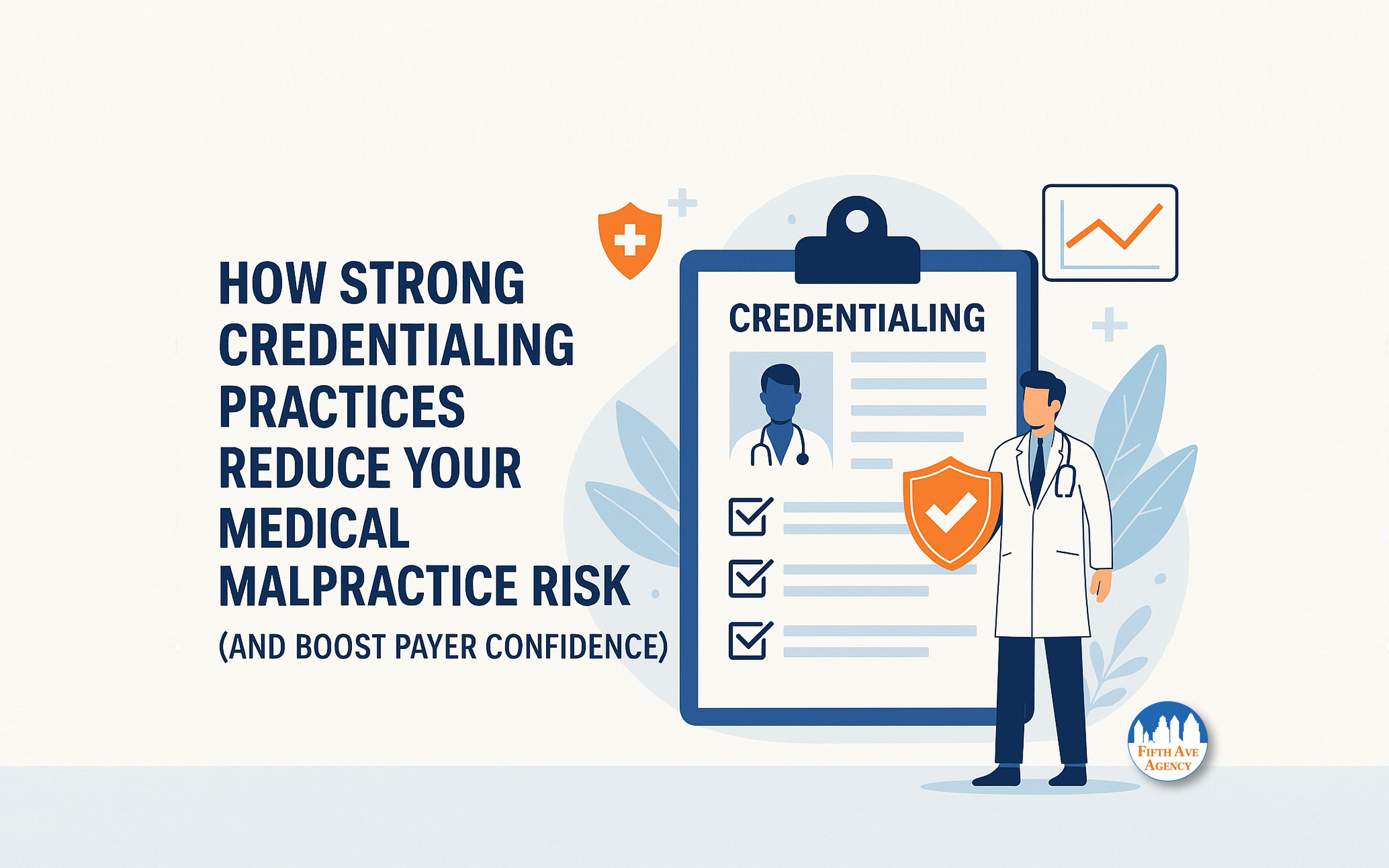Provider enrollment and primary source verification are often called ‘credentialing,’ but they are different. Here are some of the critical differences.
Credentialing often refers to many facets of a complex process used by the healthcare provider, healthcare payer (carrier), and healthcare employer (facility). This article will focus on two specific areas in the credentialing process: primary source verification of a provider’s background documentation and provider enrollment with payers.
When discussing credentialing, certain aspects of the process are often referred to as credentialing when the reference may be specific to provider enrollment and primary source verification (psv). Still, both processes are often referred to as ‘credentialing’ during discussion. Various sources provide similar definitions for both processes, confusing people outside those specialized fields of work.
Learning the differences between provider enrollment and primary source verification (psv) can be helpful and requires knowing how each process is technically defined.
What is provider enrollment credentialing?
Provider enrollment places healthcare providers into contract agreements with payers such as health insurance carriers, healthcare networks, Medicare, and Medicaid for the provider to be able to begin billing and receiving payment for services rendered.
In other words, provider enrollment allows doctors to charge their patients for treatment to begin bringing in revenue.
What is primary source verification (psv) credentialing?
Primary source verification (psv) is the initial portion of the provider enrollment process that verifies a healthcare provider’s qualifications to treat patients. PSV is often completed as a standalone process as psv documentation can also be used in obtaining privileges with hospitals and necessary in completing provider enrollment.
Primary source verification can also be performed separately, such as in cases where a healthcare organization like a hospital is about to hire a provider. The organization hiring a provider wants to verify the provider’s education and work history and the validity of their licenses.
To better understand the difference between provider enrollment and primary source verification, let’s examine both processes in more detail.
The provider enrollment process contains 3 essential stages:
- Completing the enrollment form
- Credentialing the provider
- Contracting with the insurance carrier/health plan

1. Provider Enrollment: Enrollment Application Stage
The first stage of the provider enrollment process requires the healthcare provider to complete the enrollment application form. Some applications can be completed online.
When an enrollment application is completed, the carrier reviews the application.
At this point, the carrier typically gathers the provider’s references and all other required information. This information is submitted to the carrier’s review committee for further review. They will determine whether or not to allow the provider to join their network. This stage of the process takes a substantial amount of time.
2. Provider Enrollment: Primary Source Verification Stage
The second stage of provider enrollment is the most in-depth step in the entire process. This stage of the process takes a substantial amount of time as the information requested can vary depending on the specialty of the provider, the State where the provider is located, and even each payer can have varying requirements. Credentialing the healthcare provider can take up to 90 days. However, if there is missing or incorrect information on the application, the process can take up to 120 days.
In this case, the payers typically perform the primary source verification as part of their provider enrollment process. Still, primary source verification work can be completed by an in-house team or outsourced to a cvo such as 5ACVO, depending on the requirements and uses for the credentialing documentation.
Primary source verification involves an intricate series of steps that can include:
- Sending, tracking, and receiving the provider application packet. The packet contains the provider’s contact information, tax ID numbers, and W-9 form.
- Getting the provider’s release so the credentialing agency can access the provider’s information.
- Getting privilege forms. These allow the provider to render diagnostic services to patients.
- Reviewing the disclosure’s questions and answers.
- Reviewing the explanations of any employment gaps and claims history. If gaps aren’t accounted for, the credentialing process stops here.
- Reviewing medical malpractice claims history. Malpractice claims can raise questions about whether or not to credential the provider.
- Acquiring applicable certificate copies of Board, ECFMG (Education Certificate for Foreign Medical Graduates), Medical School, Internship, Residency, Fellowship, and two years CME (Continuing Medical Education).
- Obtaining copies of government-issued photo ID, DEA (Drug Enforcement Administration), and CDS (controlled and dangerous substances). DEA and CDS certificates permit the provider to prescribe controlled substances.
- Obtaining copies of CPR (cardiopulmonary resuscitation), ACLS (advanced cardiac life support), and PALS (Pediatric Advanced Life Support) certificates.
- Getting copies of TB (tuberculosis), MMR (measles, mumps, and rubella), varicella, and flu vaccination records.
- Attesting any conflict of interest between a provider’s interests and their ability to perform their duties.
- Ordering a criminal background check.
- Getting an Allied Health Professional’s Supervising Physician’s Statement shows that a supervising physician agrees to oversee the provider.
- Here is a more exhaustive list of some 52 conventional credentialing items.
3. Provider Enrollment: Contracting Stage
Typically, the third step can begin after the healthcare provider is successfully credentialed. Credentialed providers will be offered a contract allowing them to participate in the particular health plan. The healthcare providers will be offered the terms of the agreement, reimbursement rates, participation responsibilities, and other pertinent information.
Once the provider accepts the terms of the deal, they will be given an agreement effective date and provider number. These two items enable the provider to start submitting claims. Sometimes, this contract process involves negotiating terms; other times, it is simply a matter of navigating through the process without being allowed adjustments.
The provider enrollment process of Medicare and Medicaid differs from private insurance networks. The basic process is the same, but one should note some key differences in Medical and Medicaid enrollment:
- A standard form has to be completed before a provider can apply for enrollment. The paper will then be sent to a designated intermediary. This person will handle all the administrative work for the rest of the process.
- The healthcare provider must have a primary location of service already in place.
- The healthcare provider must set up a method to receive EFT (Electronic funds transfer) payments to be reimbursed.
- Personal information of all the practice or medical organization owners must be submitted.
- Healthcare providers who are Native Americans must turn in their citizenship documents.
- Any healthcare provider whose education has not been done in the US must submit their ECFMG (Educational Commission for Foreign Medical Graduates) certificate.
Why are provider enrollment and primary source verifications necessary?
Provider enrollment is necessary because it’s the lynchpin of the medical revenue cycle. Most patients seeking treatment rely on insurance to cover their medical charges. They usually prefer visiting a provider listed as in-network on their insurance plan. Conversely, healthcare providers can not claim insurance bills unless enrolled in an insurance program. A medical practice or organization will lose revenue if they employ a provider not part of a health plan.
Primary source verification can eliminate providers deemed unfit or unqualified to administer treatment to patients. This can help reduce patient injuries and deaths. Credentialing can also help medical practices and organizations reduce their chances of facing medical malpractice lawsuits.
Provider enrollment and primary source verification are essential for healthcare professionals, their patients, and the medical industry. The process can prove daunting with all of the steps and regulations that one must follow to ensure the proper and quick provider enrollment into a health plan. Credentialing requires a keen eye for details, concentration, and knowledge about provider enrollment and proper primary source verification procedures.
Sometimes, mistakes may happen when a medical organization performs the entire process in-office. These errors can negatively impact the approval wait time, resulting in loss of revenue and wasted time. Some organizations outsource provider enrollment and primary source verification to companies solely specializing in those areas. Outsourcing enrollment can make the entire process less stressful for all involved and achieve a quicker turnaround so providers can begin seeing patients quickly. Patients can rest assured that the provider they visit is properly vetted and qualified to provide the medical services they offer.
More information about Primoris Credentialing Network
Primoris Credentialing Network specializes in credentialing and provider enrollment with 54+ health plan and network provider enrollment options. Primoris is a family member of Fifth Avenue Healthcare Services. Sister companies include 5ACVO (credentialing and primary source verification specialists) and Fifth Avenue Agency (MPLI and medical malpractice specialists).
Primoris initially published this article here. For more information on Primoris Credentialing Network, please visit PrimorisCredentialingNetwork.com or Contact Us.

















